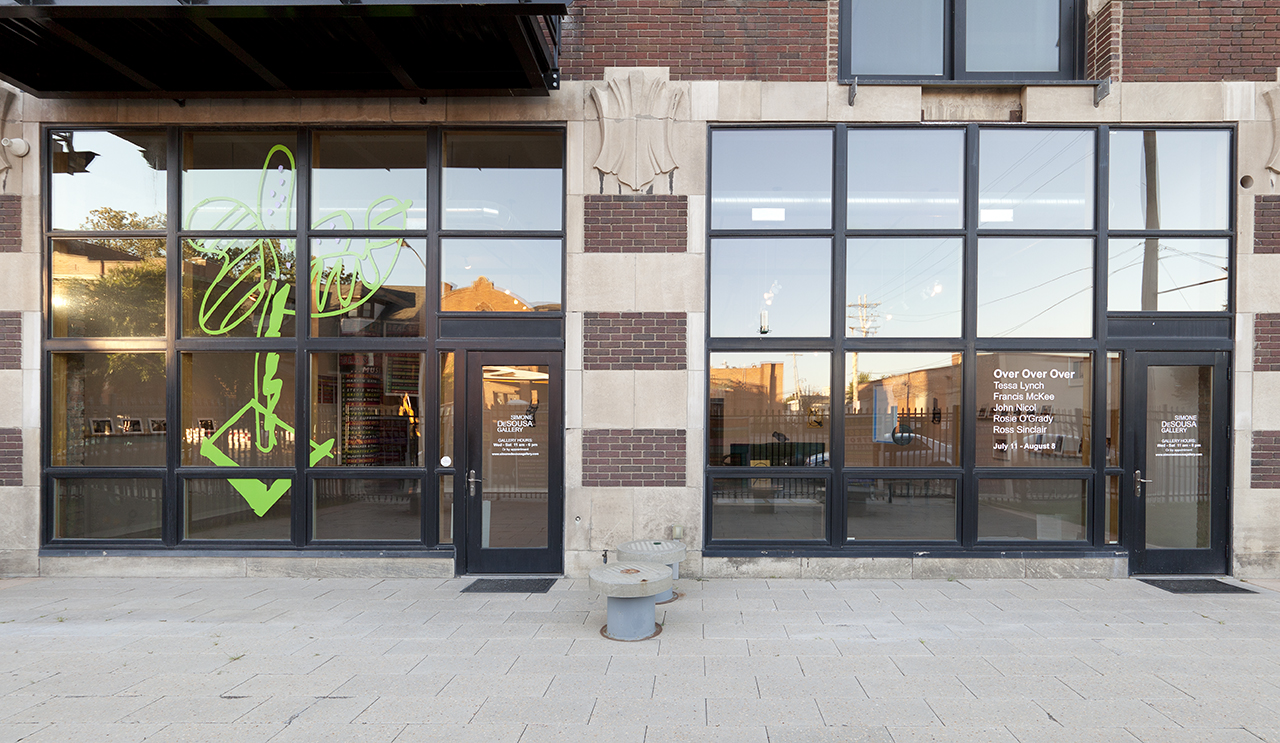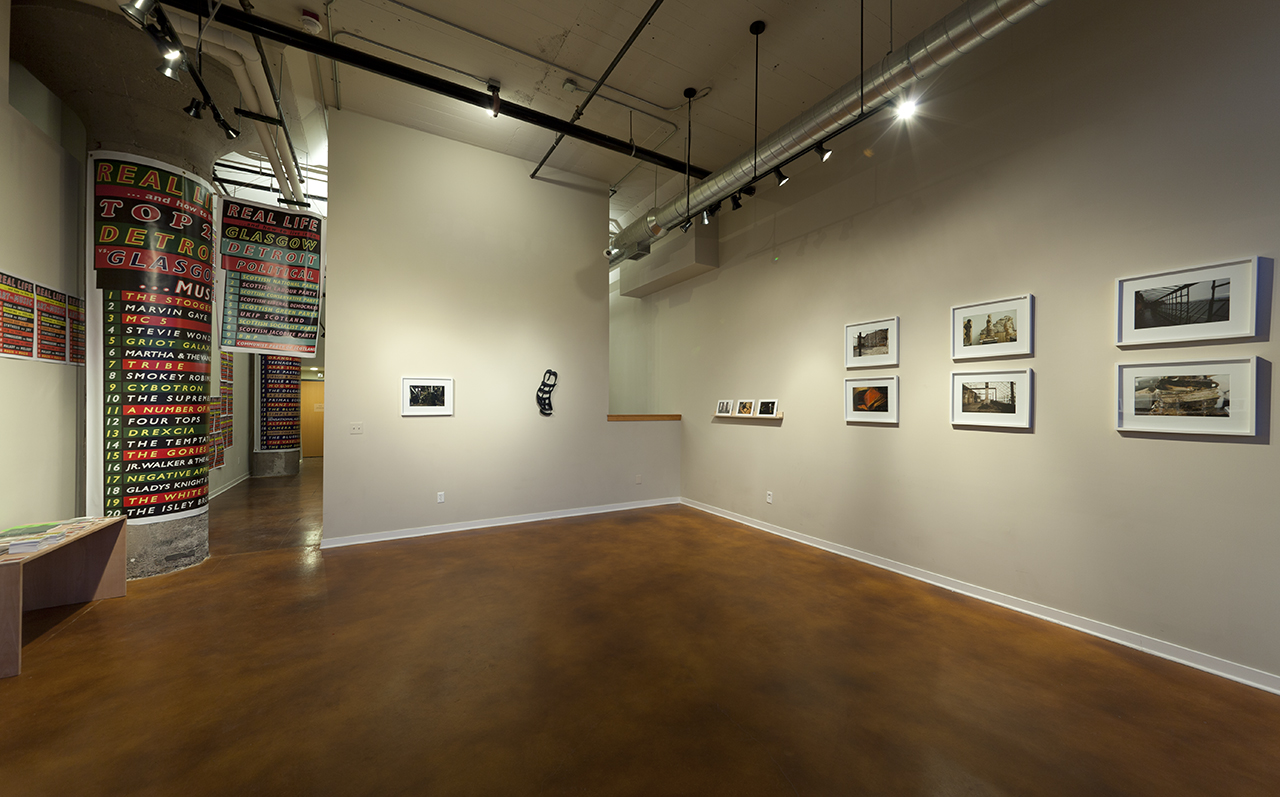
A group gallery show kicks off an artistic dialogue between Detroit and Glasgow
Photo: Exterior view of the Simone DeSousa Gallery in Detroit, featuring a neon sketch by artist Tessa Lynch in the windows.
Much has been made lately of art as social practice and the impact that artists can have in shaping communities. In the interest of creating a dynamic international conversation, Detroit artist Cedric Tai guest-curated a group show at Simone DeSousa Gallery. Titled “Over Over Over,” the exhibition ran through Aug. 8 and featured five artists from Glasgow, Scotland.
The show emerged from Tai’s graduate studies at the Glasgow School of Art, and it is part of a project that aims to create a vibrant cultural exchange between Detroit and Glasgow—two post-industrial cities a world apart, but with much to say to each other. (Tai’s project is a finalist in the 2015 Detroit Knight Arts Challenge.)
In this context, “Over Over Over”—which gathered five powerful players in the Glasgow art scene into one incredibly dense gallery experience—can be seen as merely a beginning for a conversation that is evolving by the minute. As Tai said, “Don’t trust what you see, because it will have already changed.”
Gallery owner Simone DeSousa said that handing the reins over to Tai to support his curatorial ambitions is part of the gallery’s mission to fully empower its artists.
“People sometimes leave galleries out of the equation because they seem so detached, but in order for an art scene to thrive, there need to be environments where it can flourish—venues that are engaged and supportive,” she said.
The featured artists in “Over Over Over” were Tessa Lynch, Francis Mckee, Rosie O’Grady, John Nicol and Ross Sinclair. Two of them, Mckee and Nicol, were able to spend time in Detroit for the show. While little of the work speaks directly to Detroit, much of it deals with themes that resonate deeply in this environment of economic extremes: loss and rebuilding, interaction with nature, and the power of rebranding and marketing.

Some of John Nicol’s timepieces.
Rosie O’Grady could not make the trip, so her participation in the show literally acted as a mechanism for collecting on-the-ground data from Detroit. For example, O’Grady tracked the staff of Avalon Bakery, which is located next door to the gallery, via pedometers, and she encouraged gallery visitors to collect and return environmental data, such as rainfall, over the course of the show’s run. Her work also included the localized placement of a hygrothermograph—a device that is often used in museums to measure both humidity and temperature.
Tessa Lynch, who was also unable to make the trip to the U.S., instead contributed drawings based on her conceptualization of what it would be like if she lived and worked in Detroit—based, in part, on long conversations she had with Tai and Detroit artist Corrie Baldauf.
The sketches, one of which adorned the front windows of the gallery, are “related to our moment,” DeSousa said. “We’re all unsure of what the concrete evolution of things is in the city, but we’re all sketching ideas of things in the city.”
Francis Mckee was able to make it to Detroit, and the connections forged by Tai have sparked some promising beginnings for residencies and exchanges between Glasgow and Detroit. A writer, influential teacher and director of the Centre for Contemporary Arts in Glasgow, Mckee ended up doing a short residency at Popps Packing–a program made possible in part through a Knight Arts Challenge grant. A large number of his pieces in “Over Over Over” were photographic.
“I started from typical thoughts of Detroit and ‘ruin porn’ photography of the city,” Mckee said. “I had been photographing the fire-damaged School of Art in Glasgow, and while I knew I should be lamenting the architectural loss, I found there was a fascinating alternative view of [architect Charles Rennie] Mackintosh emerging from the ruins, and a strange, beautiful–almost subacqueous–landscape emerging in the building, particularly around the statues and walls. The soot and then the fire brigades’ water combined to create an underwater world.”

Ross Sinclair’s “Top Ten” signage on the left; Francis Mckee’s photography on the right.
John Nicol’s installation examined ideas of value and time, conceptualized through knock-off watches that he bought online and onto which he painted original works, calling into question the value of these objects, being acted upon by market forces and environment. Nicol was the other member of the Glasgow contingent able to make the journey Stateside, and he passed time in Detroit working in Tai’s studio space.
Finally, Ross Sinclair’s ongoing work of soliciting and reproducing highly subjective “Top Ten” lists in the form of promotional materials intersects directly with Detroit, which is itself at a crossroads in terms of the way it is being packaged and presented to outsiders, and by whom. Sinclair’s colorful and engaging postcards, coasters and signage disseminate hierarchical rankings in such a way as to provoke questions about who determines these rankings in the first place.
These were all very productive concepts, and ones that will hopefully see further chronicles as Tai and his cohorts forge ahead in their effort to build conceptual bridges across oceans.
Recent Content
-
Artsarticle ·
-
Artsarticle ·
-
Artsarticle ·
